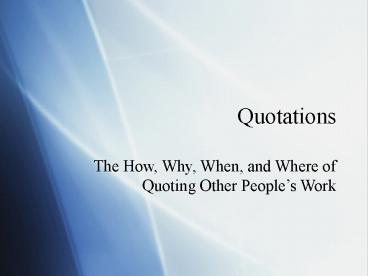Quotations PowerPoint PPT Presentation
Title: Quotations
1
Quotations
- The How, Why, When, and Where of Quoting Other
Peoples Work
2
Why Use Quotes?
- Quotations can provide important pieces of
evidence. - They can also lend a fresh voice to your writing.
3
When Should I Use Quotes?
- Use them at strategically selected moments in
your writing - Keep in mind, the majority of your paper should
be YOUR original ideas. - Using quotes, paraphrasing, and data works to
support YOUR ideas.
4
1. Discussing Specific Arguments or Ideas.
- Ex.
- Ellen Bailey reports that Langston Hughes was
a central figure of the Harlem Renaissance
(Langston Hughes). What she fails to do,
however, is give credit to the many other artists
and poets who preceded Hughes and influenced him.
5
2. Giving added emphasis to a particularly
authoritative source on your topic.
- Ex.
- During Langstons childhood, he suffered not
only because of the mistreatment of
African-Americans, but also because of his
poverty. Bailey notes Langstons grandmothers
poverty was a source of embarrassment and
ridicule (Langston Hughes).
6
How do I set up and follow up a quotation?
- Once you've carefully selected the quotations
that you want to use, your next job is to weave
those quotations into your text. - -The words that precede and follow a quotation
are just as important as the quotation itself.
7
Step 1 Provide a context for each quotation.
- Do not rely on quotations to tell your story for
you. - Because Langston had spent his life being raised
by his grandmother, he decided as a teenager to
visit his father in Mexico. This decision was met
by his mothers objections (Langston Hughes).
8
Step 2 Attribute each quotation to its source.
- Even if you place an internal citation after a
quotation, you must still attribute the quotation
within the text. - Try to use words such as observed, argued,
wrote, and declared.
9
Step 3 Explain the significance of the
quotation.
- Once you've inserted your quotation, along with
its context and attribution, don't stop! - Your reader still needs your assessment of why
the quotation holds significance for your paper. - Poets are often known for their moodiness.
Langston was no exception. There was a time
during his struggles with his father that he
contemplated suicide (Langston Hughes). This
frustration and anxiety was eventually poured
into his poetry.
10
How much should I quote?
- As few words as possible.
- Remember, your paper should primarily contain
your own words, so quote only the most witty and
memorable parts of sources.
11
Guidelines for selecting what to quote
- Excerpt fragments.
- (Sometimes, you should quote short fragments,
rather than whole sentences.)
12
- 2. Excerpt those fragments carefully!
- -Quoting the words of others carries a big
responsibility. - Well-known poet Langston Hughes really only held
menial jobs (Langston Hughes).
13
- 3. Use block quotations sparingly.
- -There may be times when you need to quote long
passages. - -However, you should use block quotations only
when you fear that omitting any words will
destroy the integrity of the passage
14
Step 4 Provide a citation for the quotation.
- All quotations, just like all paraphrases,
require a formal citation. - Place the parenthetical reference after--not
within--the closed quotation mark.

